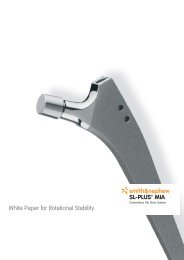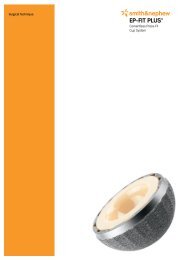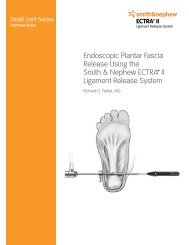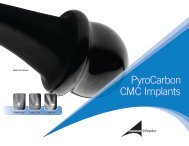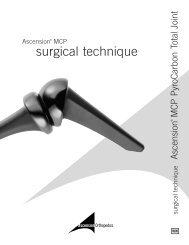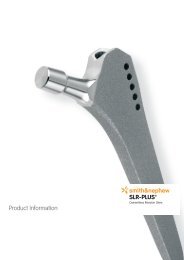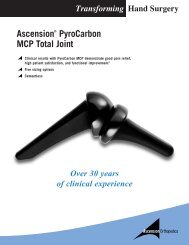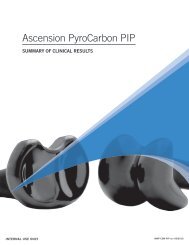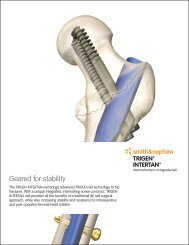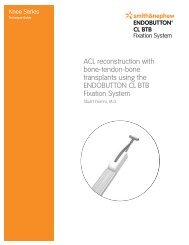SYNERGY Cementless - Smith & Nephew
SYNERGY Cementless - Smith & Nephew
SYNERGY Cementless - Smith & Nephew
Create successful ePaper yourself
Turn your PDF publications into a flip-book with our unique Google optimized e-Paper software.
<strong>SYNERGY</strong> <strong>Cementless</strong> Stem<br />
Indications<br />
Both cemented and cementless femoral<br />
components have demonstrated long-term<br />
durability in the treatment of severe arthritic<br />
conditions of the hip. An algorithm has been<br />
developed that helps define which implant<br />
matches each patient’s needs. The algorithm<br />
takes into consideration patient age, bone<br />
stock, disease type and implant cost.<br />
Algorithm for Implant Selection<br />
<strong>Cementless</strong> Cemented<br />
Age Under 75 Over 75<br />
Medullary Canal Funnel Shaped Cylindrical<br />
Disease Osteoarthritis Inflammatory<br />
Cost Type High-Demand Low-Demand<br />
Preoperative Planning<br />
The goal of preoperative planning is to<br />
determine the correct stem size, level<br />
of the femoral neck cut, and proper<br />
head and stem offset combination.<br />
Preoperative templating requires at least<br />
an anteroposterior radiograph of the pelvis<br />
and a lateral radiograph of the affected<br />
hip. If the opposite hip is unaffected by<br />
disease, it can often provide accurate sizing<br />
information for the femoral stem. <strong>SYNERGY</strong><br />
stems gain immediate, rigid fixation through<br />
3-point contact with the femur. This is best<br />
appreciated by viewing a lateral postoperative<br />
radiograph as shown in Figure 1.<br />
Figure 1<br />
Postoperative<br />
lateral radiograph<br />
of a porous-coated<br />
<strong>SYNERGY</strong> stem<br />
showing 3-point<br />
fixation<br />
As can be seen in Figure 1, the stem has direct<br />
contact with hard cortical bone at 3 points:<br />
proximally at the posterior aspect of the femur,<br />
anteriorly in the midsection of the stem, and<br />
posteriorly above the polished distal tip of<br />
the stem.<br />
6



